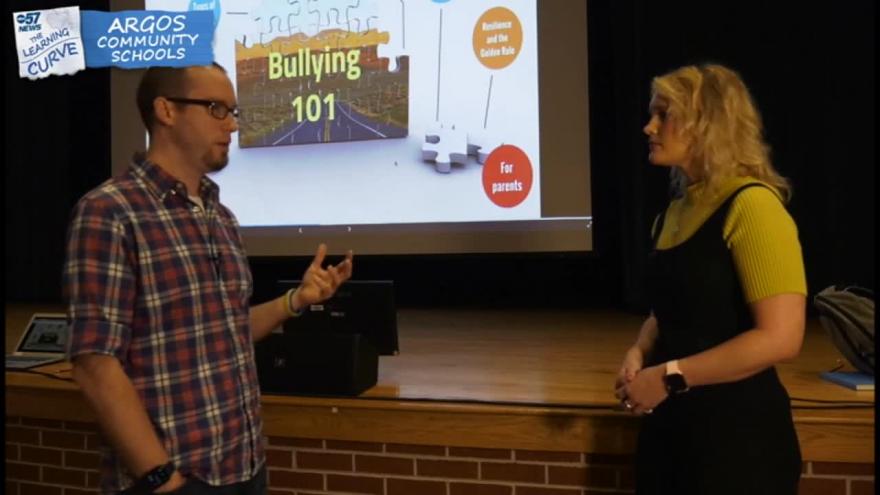The Learning Curve: Argos students discuss bullying, counselor provides protocol
ARGOS, Ind. -- The Learning Curve dives deeper into the people entrusted with helping students get through tough, uncalled for situations.
Learning Curve reporter and morning anchor, Summer Horan, asked students at Argos’ Junior/Senior High School whether they believe they have been bullied before.
Bullying as per the definition from the Indiana Department of Education that says it, “identifies these incidents as repeated, unwanted, aggressive behavior involving an observed or perceived power imbalance.
The student’s answers were mixed.
“Not necessarily, for me,” said 8th grader, Tommy Thompson.
“I've experienced my friend getting bullied a lot.” (BUTT) “So I kind of like, know, what, how have some people feel about that,” said fellow 8th grader, Grace Thomas.
“Oh, I don’t think it was bullying, more so people just trying to be mean, and just trying to make me feel bad,” said 8th grader, Ioan Petz.
However, one student said she was bullied the morning she was interviewed.
“Earlier today, actually. Second period, yeah,” said 8th grader, Sydney Lewark. “I was messing around with supposedly one of my guy friends. And he called me fat.”
Horan went on to ask the students who have seen or experienced bullying what they did in that moment.
“I just kept quiet and kept to myself kept doing my work,” said Lewark.
“I just tried to ignore it and just try comforting myself with talking to someone else,” said Petz.
“I kind of just helped her build her self esteem up. And I kind of just say, like, don't listen to them. They're not, they're not true. They don't speak truly or anything like that,” said Thomas.
It’s a variety of coping skills and incidents that counselor, Beth Schmeltz, has experienced over the course of her 37 years in education.
“I have all the students grades six through, so I have all those grade levels. Some days are, you know, not as hectic as others, but when it rains, it pours, and I'm one person,” said Schmeltz.
Schmeltz works with teacher’s on mitigation strategies and classroom discipline.
“They look out for those things, and they'll address it, they'll call kids out,” said Schmeltz.
The counselor has an open door policy for anyone in need of a listening ear.
“I have out in the hallway a note that they can request to see the counselor. So students will fill that out and drop it in,” said Schmeltz. “I'll get emails from students sometimes but probably more often, is they'll just show up at my door. They’ll say ‘Can I come in and talk to you about something’ and then I go from there.”
Some students I spoke with say the best thing they can do if they see or experience bullying is…
“I would probably want to talk to someone and I would want to get the threat away,” said Petz.
“Talk to someone Definitely. It's a best friend, sister, brother. therapist, counselor,” said Lewark.
Even with the right tools, trusted adults and a school resource officer right down the hallway—Schmeltz said fear keeps kids and parents in need, far from help.
“I find it can be kind of frustrating, I'll even have parents that will say that, you know, I didn't say anything, because, you know, my child thought it would get worse, or I thought it would just get worse. So I didn't want to bring it up,” said Schmeltz.
Even when honesty can be the first stepping stone to change.
“Any report of bullying behavior is investigated,” said Schmeltz.
Starting with conversations with those involved.
“But if it continues, and they've been talked with, and they're not correcting that behavior, then it would move to more of a disciplinary situation,” said Schmeltz.
Even with a code of conduct at school, it seems fear still shuts students out.
If you look at the IDOE’s Bullying Report for the 2021 school year, you can see every school district in the state and the number of bullying incidents recorded to the state.
When you look up Argos’ state recorded bullying incidents, all you see are zeros, mirroring several other Michiana Schools.
It is important to note this particular time frame was during the pandemic which kept many students away from in-person classes during most of the school year.
But still, sometimes, courage isn’t enough.
“But like there are shy people. And they choose to try and keep to themselves and like just bury it inside. And sometimes you just gotta let it out. Tell people,” said Lewark.
And when reporting isn’t a kid’s first option?
“I think more adults need to step in. And more adults need to, like, take this seriously and not just be eh, okay,” said Thomas.
“We should probably get more information about bullying to kids and try stopping people from bullying when they're younger so they don't turn into a bully,” said Petz.
The students asked for more information and that is just what Counselor Schmeltz delivered!
Join the Learning Curve team next week, April 28th, to hear from a Marshall County mental health center on the modern day approaches they take to mitigate and discuss bullying.















